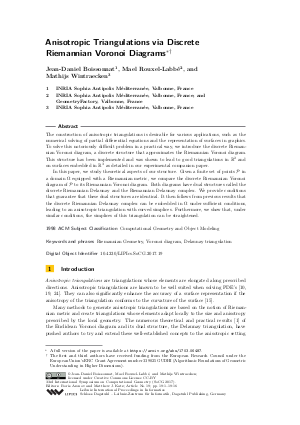Anisotropic Triangulations via Discrete Riemannian Voronoi Diagrams
Authors Jean-Daniel Boissonnat, Mael Rouxel-Labbé, Mathijs Wintraecken
-
Part of:
Volume:
33rd International Symposium on Computational Geometry (SoCG 2017)
Part of: Series: Leibniz International Proceedings in Informatics (LIPIcs)
Part of: Conference: Symposium on Computational Geometry (SoCG) - License:
 Creative Commons Attribution 3.0 Unported license
Creative Commons Attribution 3.0 Unported license
- Publication Date: 2017-06-20
File

PDF
LIPIcs.SoCG.2017.19.pdf
- Filesize: 1.69 MB
- 16 pages
Document Identifiers
Subject Classification
Keywords
- Riemannian Geometry
- Voronoi diagram
- Delaunay triangulation
Metrics
- Access Statistics
-
Total Accesses (updated on a weekly basis)
0Document
0Metadata
Abstract
The construction of anisotropic triangulations is desirable for various applications, such as the numerical solving of partial differential equations and the representation of surfaces in graphics. To solve this notoriously difficult problem in a practical way, we introduce the discrete Riemannian Voronoi diagram, a discrete structure that approximates the Riemannian Voronoi diagram. This structure has been implemented and was shown to lead to good triangulations in R^2 and on surfaces embedded in R^3 as detailed in our experimental companion paper. In this paper, we study theoretical aspects of our structure. Given a finite set of points P in a domain Omega equipped with a Riemannian metric, we compare the discrete Riemannian Voronoi diagram of P to its Riemannian Voronoi diagram. Both diagrams have dual structures called the discrete Riemannian Delaunay and the Riemannian Delaunay complex. We provide conditions that guarantee that these dual structures are identical. It then follows from previous results that the discrete Riemannian Delaunay complex can be embedded in Omega under sufficient conditions, leading to an anisotropic triangulation with curved simplices. Furthermore, we show that, under similar conditions, the simplices of this triangulation can be straightened.
Cite As Get BibTex
Jean-Daniel Boissonnat, Mael Rouxel-Labbé, and Mathijs Wintraecken. Anisotropic Triangulations via Discrete Riemannian Voronoi Diagrams. In 33rd International Symposium on Computational Geometry (SoCG 2017). Leibniz International Proceedings in Informatics (LIPIcs), Volume 77, pp. 19:1-19:16, Schloss Dagstuhl – Leibniz-Zentrum für Informatik (2017)
https://doi.org/10.4230/LIPIcs.SoCG.2017.19
BibTex
@InProceedings{boissonnat_et_al:LIPIcs.SoCG.2017.19,
author = {Boissonnat, Jean-Daniel and Rouxel-Labb\'{e}, Mael and Wintraecken, Mathijs},
title = {{Anisotropic Triangulations via Discrete Riemannian Voronoi Diagrams}},
booktitle = {33rd International Symposium on Computational Geometry (SoCG 2017)},
pages = {19:1--19:16},
series = {Leibniz International Proceedings in Informatics (LIPIcs)},
ISBN = {978-3-95977-038-5},
ISSN = {1868-8969},
year = {2017},
volume = {77},
editor = {Aronov, Boris and Katz, Matthew J.},
publisher = {Schloss Dagstuhl -- Leibniz-Zentrum f{\"u}r Informatik},
address = {Dagstuhl, Germany},
URL = {https://drops.dagstuhl.de/entities/document/10.4230/LIPIcs.SoCG.2017.19},
URN = {urn:nbn:de:0030-drops-72060},
doi = {10.4230/LIPIcs.SoCG.2017.19},
annote = {Keywords: Riemannian Geometry, Voronoi diagram, Delaunay triangulation}
}
Author Details
References
-
F. Aurenhammer and R. Klein. Voronoi diagrams. In J. Sack and G. Urrutia, editors, Handbook of Computational Geometry, pages 201-290. Elsevier Science Publishing, 2000.

-
J.-D. Boissonnat, R. Dyer, and A. Ghosh. Delaunay triangulation of manifolds. Foundations of Computational Mathematics, pages 1-33, 2017.

-
J.-D. Boissonnat, R. Dyer, A. Ghosh, and S. Y. Oudot. Only distances are required to reconstruct submanifolds. Comp. Geom. Theory and Appl., 2016. To appear.

- J.-D. Boissonnat, M. Rouxel-Labbé, and M. Wintraecken. Anisotropic triangulations via discrete Riemannian Voronoi diagrams, 2017. URL: https://arxiv.org/abs/1703.06487.
-
M. Campen, M. Heistermann, and L. Kobbelt. Practical anisotropic geodesy. In Proceedings of the Eleventh Eurographics/ACMSIGGRAPH Symposium on Geometry Processing, SGP'13, pages 63-71. Eurographics Association, 2013.

-
G. D. Cañas and S. J. Gortler. Orphan-free anisotropic Voronoi diagrams. Discrete and Computational Geometry, 46(3), 2011.

-
G. D. Cañas and S. J. Gortler. Duals of orphan-free anisotropic Voronoi diagrams are embedded meshes. In SoCG, pages 219-228. ACM, 2012.

-
T. Cao, H. Edelsbrunner, and T. Tan. Proof of correctness of the digital Delaunay triangulation algorithm. Comp. Geo.: Theory and Applications, 48, 2015.

-
S.-W. Cheng, T. K. Dey, E. A. Ramos, and R. Wenger. Anisotropic surface meshing. In Proceedings of the Seventeenth Annual ACM-SIAM Symposium on Discrete Algorithms, pages 202-211. Society for Industrial and Applied Mathematics, 2006.

-
E. F. D'Azevedo and R. B. Simpson. On optimal interpolation triangle incidences. SIAM J. Sci. Statist. Comput., 10(6):1063-1075, 1989.

-
T. K. Dey, F. Fan, and Y. Wang. Graph induced complex on point data. Computational Geometry, 48(8):575-588, 2015.

-
Q. Du and D. Wang. Anisotropic centroidal Voronoi tessellations and their applications. SIAM Journal on Scientific Computing, 26(3):737-761, 2005.

-
R. Dyer, G. Vegter, and M. Wintraecken. Riemannian simplices and triangulations. Preprint: arXiv:1406.3740, 2014.

-
R. Dyer, H. Zhang, and T. Möller. Surface sampling and the intrinsic Voronoi diagram. Computer Graphics Forum, 27(5):1393-1402, 2008.

-
M. Garland and P. S. Heckbert. Surface simplification using quadric error metrics. In ACM SIGGRAPH, pages 209-216, 1997.

-
H. Karcher. Riemannian center of mass and mollifier smoothing. Communications on Pure and Applied Mathematics, 30:509-541, 1977.

-
F. Labelle and J. R. Shewchuk. Anisotropic Voronoi diagrams and guaranteed-quality anisotropic mesh generation. In SCG'03: Proceedings of the Nineteenth Annual Symposium on Computational Geometry, pages 191-200. ACM, 2003.

-
G. Leibon. Random Delaunay triangulations, the Thurston-Andreev theorem, and metric uniformization. PhD thesis, UCSD, 1999.

-
J.-M. Mirebeau. Optimal meshes for finite elements of arbitrary order. Constructive approximation, 32(2):339-383, 2010.

-
P. Niyogi, S. Smale, and S. Weinberger. Finding the homology of submanifolds with high confidence from random samples. Discrete &Comp. Geom., 39(1-3), 2008.

-
G. Peyré, M. Péchaud, R. Keriven, and L. D. Cohen. Geodesic methods in computer vision and graphics. Found. Trends. Comput. Graph. Vis., 2010.

-
C. Rourke and B. Sanderson. Introduction to piecewise-linear topology. Springer Science &Business Media, 2012.

-
M. Rouxel-Labbé, M. Wintraecken, and J.-D. Boissonnat. Discretized Riemannian Delaunay triangulations. In Proc. of the 25th Intern. Mesh. Round. Elsevier, 2016.

-
J. R. Shewchuk. What is a good linear finite element? Interpolation, conditioning, anisotropy, and quality measures, Manuscript 2002.

-
E. Sperner. Fifty years of further development of a combinatorial lemma. Numerical solution of highly nonlinear problems, pages 183-197, 1980.

